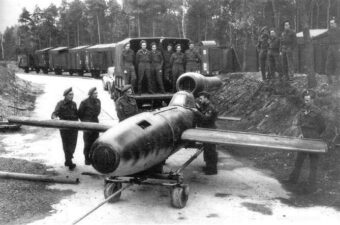“Unveiling the Bizarre: How Nazi Germany Crafted a Wooden Weapon of War That Defied Belief”
By 1944, German cities were being pounded to rubble by round-the-clock Allied bombing raids, with the Americans bombing by day and the British by Night. With many of its factories and airfields damaged or destroyed by the bombing and the bulk of its forces already committed to the Eastern Front, the German Air Force or Luftwaffe found itself desperately short of aircraft, fuel, and pilots, and struggling to hold off the Allied onslaught. The Nazi High Command thus turned to a variety of high-tech “wonder weapons” in a desperate attempt to stem the tide. These weapons included the Messerschmitt Me-262 Schwalbe, the world’s first operational jet fighter; the rocket-powered Messerschmitt Me-163 Komet; and guided surface-to-air missiles like the Rheintochter, Enzian, Schmetterling, and Wasserfall. However, none of these advanced weapons came close to solving the problem – for a variety of reasons. As covered in our previous video The German Rocket Fighter That Dissolved Its Pilots Alive, while the Komet was faster than any contemporary Allied fighter aircraft, the fuels used by its engine were extremely volatile and had a tendency to blow up – or, as the title of that video suggests, dissolve its pilots – during rough landings. It also had an extremely short endurance, forcing Komet squadrons to be stationed close to the targets they were protecting and the aircraft to glide to a landing once their fuel ran out. This made the aircraft extremely vulnerable. The very same problem afflicted the Me-262 jet fighter, with the majority being shot down by marauding Allied fighters as they came in for a landing. Meanwhile, while Germany’s various guided missile projects showed promise, they were too complex and developed too hastily and too late to become viable weapons by the time the war ended. They were also developed separately by different branches of the German armed forces, leading to wasteful duplication of effort and competition for scarce resources. But what truly doomed these projects was the large quantities of raw materials and manpower they required to produce – resources Germany was swiftly running out of. So, on September 10, 1944, the German Air Ministry or RLM issued a set of requirements for an “Emergency Fighter” that could be produced in large numbers using non-strategic materials and semi-skilled labour and flown by pilots with only minimal training. One design to come out of these requirements was the Heinkel He-162 Volksjager or “people’s fighter”, which we have already covered in our previous video The Jet the Nazis Designed to be Flown by Children. But a far more radical was a concept submitted by engineer Erich Bachem of Fieseler Aircraft Works in Kassel.











